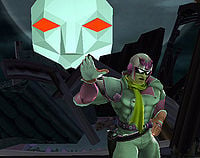Taunt match
A taunt match or taunt party is a type of match where players refuse to take the actual battle seriously; instead, they focus on behaviour that is aggravating or otherwise irritating to players who are interested in actually fighting. Taunt matches can be seen as a form of griefing, owing to the fact that players who start taunt matches often team up on players who attempt to take the match seriously.
Overview
Exact behaviour in taunt matches vary from match to match, but the overall concept remains the same. Contrary to their name, taunt matches do not have to specifically feature excessive or non-stop taunting from players; moves that produce repetitive, loud noises can also be done by players, such as Ganondorf's up-smash or Kirby's crouch animation. As other forms of griefing, players can also abuse glitches, hack the game to display unusual stages or force desynchs, exacerbate the lag seen on Wi-Fi via abusing moves such as Transform, or otherwise act uselessly, such as by constantly backfiring Diddy Kong's Peanut Popgun, constantly breaking their shield, or even completely refraining from performing any actions whatsoever. Costumes can also play a role in taunt matches; Captain Falcon's pink and white attire is particularly infamous in its use with taunt matches, as are Meta Knight's pink and red costume and Shulk's shirtless costume, among others. The stage of Temple is a common pick amongst taunt matches, as its large size allows players to easily avoid serious players, though the deadly stage hazards of New Pork City make that stage a relatively common pick as well.
A sense of cooperation is generally seen in taunt matches, with most of them involving a group of either two or three people on the same console all working together in the match. Cooperative players may use the same character as to synchronise taunts or to otherwise assist in preventing serious matches from occurring. Etiquette is also often displayed by those who start taunt matches; accidental attacks are sometimes followed up with the offending player crouching as a form of apology.
An idea behind a taunt match is to get all players into the spirit of the match; despite this, serious players often attempt to "force" the taunt match to end, but the presence of multiple players can make this almost impossible. Players who wish to keep the taunt match going may either constantly run away from the serious player via the aid of large stages, crowd in the same area to create a near-impregnable camping tactic, or team up on the serious player; in this regard, the use of Mr. Game & Watch is popular with characters such as Samus or Ness, due to his Oil Panic move, though other strategies may involve forcing serious players into a Falcon Punch or other moves, or otherwise merely inflicting considerable damage and then getting an easy KO.
In Super Smash Bros. Brawl
While taunt matches are theoretically possible in any mode, the anonymity of Basic Brawl allowed for numerous taunt matches to occur in the mode. In addition to numerous other perceived flaws with the mode, the inability to otherwise avoid taunt matches via a reporting system or similar method caused Basic Brawl to garner considerable criticism from players.
In Super Smash Bros. 4
As one of multiple fixes done for the game's new online mode, Smash 4 added a system as an attempt to combat players who attempt taunt matches or otherwise grief; among the offenses that players can be banned for include refraining from fighting, relentlessly targeting a specific player, intentionally self-destructing in a short period of time, performing taunts too often, and "other abuses of the system". However, in the final game, a limit to the number of taunts a player can perform in a single match is instead implemented.
Taunt matches are still a fairly common occurrence, particularly on For Fun. However, as a result of the taunting limit, they are not nearly as ubiquitous as they were in Brawl. More than in Brawl, SSB4 taunt matches see repeated use of moves such as Wario's Wario Waft, his Bike Taunt, Shulk's Back Slash and all of Robin's special moves due to their ability to bypass the taunt limit and their associated soundbites and animations, along with general ineffective use of participating characters' movesets.

